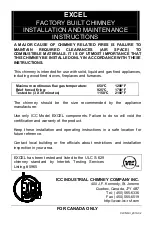
12
FP14 Cartier - Installation and Operation Manual
spend
most
of
your
time
will
be
warmest,
while
bedrooms
and
basement
(if
there
is
one)
will
stay
cooler.
In
this
way,
you
will
burn
less
wood
than
with
other
forms
of
heating.
Although
the
fireplace
may
be
able
to
heat
the
main
living
areas
of
your
house
to
an
adequate
temperature,
we
strongly
recommend
that
you
also
have
a
conventional
oil,
gas
or
electric
heating
system
to
provide
backup
heating.
Your
success
with
zone
heating
will
depend
on
several
factors,
including
the
correct
sizing
and
location
of
the
fireplace,
the
size,
layout
and
age
of
your
home
and
your
climate
zone.
Three
‐
season
vacation
homes
can
usually
be
heated
with
smaller
fireplaces
than
houses
that
are
heated
all
winter.
2.3
The
Benefits
of
Low
Emissions
and
High
Efficiency
The
low
smoke
emissions
produced
by
the
special
features
inside
the
FP14
Cartier
firebox
mean
that
your
household
will
release
up
to
90
percent
less
smoke
into
the
outside
environment
than
if
you
used
an
older
conventional
stove.
But
there
is
more
to
the
emission
control
technologies
than
protecting
the
environment.
The
smoke
released
from
wood
when
it
is
heated
contains
about
half
of
the
energy
content
of
the
fuel.
By
burning
the
wood
completely,
your
fireplace
releases
all
the
heat
energy
from
the
wood
instead
of
wasting
it
as
smoke
up
the
chimney.
Also,
the
features
inside
the
firebox
allow
you
to
reduce
the
air
supply
to
control
heat
output,
while
maintaining
clean
and
efficient
flaming
combustion,
which
boosts
the
efficient
delivery
of
heat
to
your
home.
The
emission
control
and
advanced
combustion
features
of
your
fireplace
can
only
work
properly
if
your
fuel
is
in
the
correct
moisture
content
range
of
15
to
20
percent.
See
Section
3:
Fuel
of
this
manual
for
suggestions
on
preparing
fuelwood
and
judging
its
moisture.
2.4
The
SBI
Commitment
to
You
and
the
Environment
The
SBI
team
is
committed
to
protecting
the
environment,
so
we
do
everything
we
can
to
use
only
materials
in
our
products
that
will
have
no
lasting
negative
impact
on
the
environment.
2.4.1
What
is
Your
New
Fireplace
Made
Of?
The
body
of
your
fireplace,
which
is
most
of
its
weight,
is
carbon
steel.
Should
it
ever
become
necessary
many
years
in
the
future,
almost
the
entire
fireplace
can
be
recycled
into
new
products,
thus
eliminating
the
need
to
mine
new
materials.
The
paint
coating
on
your
fireplace
is
very
thin.
Its
VOC
content
(Volatile
Organic
Compounds)
is
very
low.
VOCs
can
be
responsible
for
smog,
so
all
the
paint
used
during
the
manufacturing
process
meets
the
latest
air
quality
requirements
regarding
VOC
reduction
or
elimination.
The
air
tubes
are
stainless
steel,
which
can
also
be
recycled.
The
baffle
is
made
of
stainless
steel
and
cement.
It
is
not
considered
hazardous
waste.
Disposal
at
a
landfill
is
recommended.
Moulded
refractory
bricks
are
mainly
composed
of
silicon
dioxide,
also
known
as
silica,
a
product
processed
from
a
mined
mineral.
It
is
most
commonly
found
in
nature
in
the
form
of
sand
and
clay.
Disposal
at
a
landfill
is
recommended.
The
steel
mesh
contained
in
some
refractory
bricks
can
be
recycled.













































